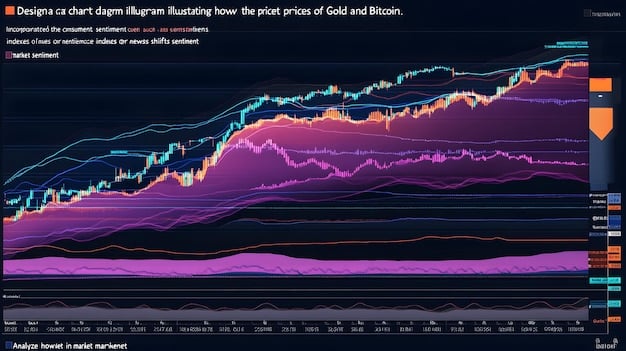Understanding Market Volatility: A Beginner’s Guide

Understanding market volatility is crucial for new investors; this guide breaks down what causes market swings, how to manage your emotions, and practical strategies to stay calm and make informed decisions during turbulent times.
Navigating the stock market can feel like riding a rollercoaster, especially when you’re new to investing. This guide, **understanding market volatility: a beginner’s guide to staying calm during market swings**, is designed to equip you with the knowledge and strategies to weather those ups and downs with confidence.
What is Market Volatility?
Market volatility refers to the degree of variation in a trading price series over time. It’s essentially a measure of how much the market is fluctuating, and how rapidly those fluctuations are occurring. High volatility means prices are swinging dramatically, while low volatility indicates a more stable market.
Factors that Influence Volatility
Several factors can contribute to market volatility, ranging from economic news to geopolitical events and investor sentiment. Understanding these drivers can help you anticipate potential market swings.
- Economic News: Reports on inflation, unemployment, GDP growth, and interest rates can significantly impact market sentiment. Unexpected or disappointing economic data often leads to increased volatility.
- Geopolitical Events: Political instability, trade wars, and global crises can disrupt markets and trigger periods of high volatility. These events introduce uncertainty, causing investors to react defensively.
- Investor Sentiment: Market psychology plays a crucial role. Fear and greed can drive buying and selling frenzies, amplifying market swings. News, rumors, and social media trends can all influence investor behavior.
Think of market volatility as the temperature of the market. Some days it’s a cool, steady breeze; other days, it’s a scorching heatwave or an icy blizzard. Being aware of the factors that can change this temperature allows you to prepare accordingly.

Understanding Volatility Metrics
Several metrics can help you gauge market volatility. These tools provide insights into the current and future potential fluctuations in the market, enabling you to make more informed investment decisions.
VIX (Volatility Index)
The VIX, often called the “fear gauge,” is a real-time index that represents the market’s expectation of 30-day volatility. It is derived from the price of S&P 500 index options and is a widely used measure of market risk.
Beta
Beta measures a security’s volatility in relation to the overall market. A beta of 1 indicates that the security’s price will move in line with the market, while a beta greater than 1 suggests higher volatility, and a beta less than 1 indicates lower volatility.
- High Beta Stocks: These stocks tend to be more sensitive to market movements and can offer higher potential returns but also carry greater risk.
- Low Beta Stocks: These stocks are generally less volatile and can provide more stability during market downturns.
Imagine the VIX as a thermometer for market anxiety, and beta as a measure of how much a particular stock reacts to that anxiety. These metrics provide a quantitative way to assess and understand market volatility.
The Impact of Volatility on Your Investments
Volatility can have a substantial impact on your investment portfolio. It can create both opportunities and risks, depending on your investment strategy and risk tolerance.
High volatility can lead to significant short-term losses, especially if you panic and sell your investments during a market downturn. However, it can also create opportunities to buy assets at lower prices, potentially leading to higher long-term returns. It’s essential to understand how volatility affects your investments and adjust your strategy accordingly.

Strategies for Staying Calm During Market Swings
Staying calm and composed during market volatility is crucial for making rational investment decisions. Emotional reactions can lead to impulsive actions that can jeopardize your financial well-being.
Long-Term Perspective
One of the most effective strategies for managing stress during market volatility is to maintain a long-term perspective. Remember that the stock market has historically trended upward over time, despite short-term fluctuations.
Focusing on your long-term financial goals can help you avoid getting caught up in the day-to-day market noise. Regularly review your investment plan and remind yourself of your objectives, such as retirement, education, or a down payment on a home.
Diversification
Diversification is a risk management technique that involves spreading your investments across different asset classes, industries, and geographic regions. By diversifying your portfolio, you can reduce the impact of any single investment on your overall returns.
- Asset Allocation: Determine the appropriate mix of stocks, bonds, and other assets based on your risk tolerance and investment goals.
- Industry Diversification: Invest in a variety of sectors to avoid overexposure to any single industry.
- Geographic Diversification: Spread your investments across different countries and regions to reduce the impact of local economic or political events.
Dollar-Cost Averaging
Dollar-cost averaging is a strategy that involves investing a fixed amount of money at regular intervals, regardless of the market price. This approach can help you avoid the risk of investing a large sum of money at the peak of the market.
Over time, dollar-cost averaging can potentially lower your average cost per share, as you will buy more shares when prices are low and fewer shares when prices are high. This strategy can also help you avoid making emotional investment decisions based on short-term market fluctuations.
Staying focused on your long-term goals, diversifying your investments, and using dollar-cost averaging can help you navigate market volatility with confidence and avoid making costly mistakes.
Building a Volatility-Ready Portfolio
Creating a portfolio that can withstand market volatility requires careful planning and a clear understanding of your risk tolerance. A well-constructed portfolio can help you achieve your financial goals while minimizing the impact of market swings.
Assess Your Risk Tolerance
Before building your portfolio, it’s essential to assess your risk tolerance. Risk tolerance refers to your ability and willingness to withstand potential losses in exchange for the opportunity to achieve higher returns.
Consider factors such as your age, financial situation, investment goals, and time horizon. Younger investors with a longer time horizon may be able to tolerate more risk, while older investors approaching retirement may prefer a more conservative approach.
Choose Appropriate Investments
Once you’ve assessed your risk tolerance, you can choose investments that align with your comfort level. Some investments are inherently more volatile than others, and it’s important to understand the risk-return profile of each asset class.
- Stocks: Stocks are generally considered to be more volatile than bonds, but they also offer the potential for higher returns over the long term.
- Bonds: Bonds are typically less volatile than stocks and can provide a more stable source of income.
- Real Estate: Real estate can be a good diversifier in a portfolio, but it can also be subject to market fluctuations and illiquidity.
Building a portfolio that aligns with your risk tolerance and investment goals can help you stay calm during market volatility and avoid making impulsive decisions.
Tools and Resources for Monitoring Volatility
Staying informed about market volatility is essential for making sound investment decisions. Several tools and resources can help you monitor volatility and stay ahead of potential market swings.
Financial News Websites
Stay up-to-date on the latest market news and analysis by following reputable financial news websites. These sources provide valuable insights into market trends, economic indicators, and geopolitical events that can impact volatility.
Volatility Tracking Tools
Several online tools and platforms allow you to track market volatility in real-time. These tools provide data on the VIX, beta, and other volatility metrics, helping you assess market risk and make informed investment decisions.
Monitoring market volatility through financial news websites and dedicated tracking tools can help you stay informed and prepared for potential market swings.
| Key Point | Brief Description |
|---|---|
| 📈 Understand Volatility | Recognize it’s a normal part of the market cycle. |
| 🧘 Stay Calm | Avoid emotional decisions during market swings. |
| 🧺 Diversify | Spread investments across different sectors. |
| 🗓️ Long-Term View | Focus on long-term goals, not short-term fluctuations. |
Frequently Asked Questions (FAQ)
Market volatility is influenced by various factors, including economic news, geopolitical events, investor sentiment, and unexpected global crises. These factors introduce uncertainty, causing investors to react, leading to price fluctuations.
Volatility can be measured using metrics like the VIX (Volatility Index), which represents market expectations for 30-day volatility, and beta, which measures a security’s volatility relative to the overall market. Tracking these metrics can provide insights.
Not necessarily. While high volatility can lead to short-term losses, it also presents opportunities to buy assets at lower prices. It largely depends on your investment strategy and risk tolerance.
Maintain a long-term perspective, diversify your portfolio, and consider using dollar-cost averaging. These strategies help mitigate risk and reduce emotional reactions to market fluctuations, promoting rational decision-making.
Dollar-cost averaging involves investing a fixed amount of money at regular intervals, regardless of the market price. This approach can help lower your average cost per share over time and reduce the risk of investing a large sum at the market’s peak.
Conclusion
Understanding market volatility is crucial for any investor, especially beginners. By learning what causes market swings, how to measure volatility, and strategies for staying calm, you can navigate the market with greater confidence and make informed decisions that align with your long-term financial goals.





